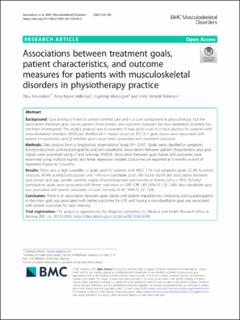| dc.contributor.author | Amundsen, Olav | |
| dc.contributor.author | Vøllestad, Nina Køpke | |
| dc.contributor.author | Meisingset, Ingebrigt | |
| dc.contributor.author | Robinson, Hilde Stendal | |
| dc.date.accessioned | 2022-02-02T14:25:05Z | |
| dc.date.available | 2022-02-02T14:25:05Z | |
| dc.date.created | 2021-06-01T19:26:33Z | |
| dc.date.issued | 2021 | |
| dc.identifier.citation | BMC Musculoskeletal Disorders. 2021, 22:182 1-12. | en_US |
| dc.identifier.issn | 1471-2474 | |
| dc.identifier.uri | https://hdl.handle.net/11250/2976711 | |
| dc.description.abstract | Sammendrag
Background
Goal setting is linked to person-centred care and is a core component in physiotherapy, but the associations between goal classes, patient characteristics and outcome measures for musculoskeletal disorders has not been investigated. The study’s purpose was to examine 1) how goals used in clinical practice for patients with musculoskeletal disorders (MSD) are distributed in classes based on ICF, 2) if goal classes were associated with patient characteristics and 3) whether goal classes were associated with treatment outcome.
Methods
Data analysis from a longitudinal observational study (N = 2591). Goals were classified in symptom, function/structure, activity/participation and non-classifiable. Associations between patient characteristics and goal classes were examined using x2 and one-way ANOVA. Association between goal classes and outcomes were examined using multiple logistic and linear regression models. Outcomes are reported at 3 months or end of treatment if prior to 3 months.
Results
There was a high variability in goals used for patients with MSD. 17% had symptom goals, 32.3% function/structure, 43.4% activity/participation and 7.4% non-classifiable goals. We found significant associations between goal classes and age, gender, severity, region of pain/diagnosis and emotional distress (all p < .001). Activity/participation goals were associated with better outcomes on GPE (OR 1.80, 95% CI 1.23–2.66). Non-classifiable goal was associated with poorer outcomes on pain intensity (B .87, 95% CI .32–1.43).
Conclusion
There is an association between goal classes and patient characteristics. Including activity/participation in the main goal was associated with better outcomes for GPE and having a non-classifiable goal was associated with poorer outcomes for pain intensity.
Trial registration
The project is approved by the Regional committee for Medical and Health Research Ethics in Norway (REC no. 2013/2030). https://clinicaltrials.gov/ct2/show/NCT03626389. | en_US |
| dc.language.iso | eng | en_US |
| dc.publisher | BMC | en_US |
| dc.rights | Navngivelse 4.0 Internasjonal | * |
| dc.rights.uri | http://creativecommons.org/licenses/by/4.0/deed.no | * |
| dc.title | Associations between treatment goals, patient characteristics, and outcome measures for patients with musculoskeletal disorders in physiotherapy practice | en_US |
| dc.type | Journal article | en_US |
| dc.type | Peer reviewed | en_US |
| dc.description.version | publishedVersion | en_US |
| dc.source.pagenumber | 1-12 | en_US |
| dc.source.volume | 22:182 | en_US |
| dc.source.journal | BMC Musculoskeletal Disorders | en_US |
| dc.identifier.doi | 10.1186/s12891-021-04048-4 | |
| dc.identifier.cristin | 1913152 | |
| cristin.ispublished | true | |
| cristin.fulltext | original | |
| cristin.qualitycode | 1 | |

